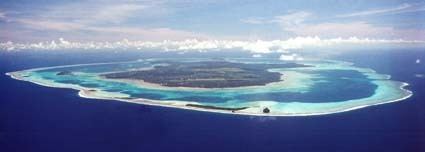Flag Coat of arms Demonym Wallisian Time zone (UTC+12) | Capitaland largest city Matāʻutu Government Overseas collectivity Area 96 km² Internet TLD .wf | |
 | ||
Official languages Wallisian (ʻUvean)French | ||
Wallis (Wallisian: ʻUvea) is a Polynesian island in the Pacific Ocean belonging to the French overseas collectivity (collectivité d'outre-mer, or COM) of Wallis and Futuna. It lies north of Tonga, northeast of Fiji, east-northeast of the Hoorn islands, east of Fiji's Rotuma, southeast of Tuvalu, southwest of Tokelau and west of Samoa. Its area is almost 100 km2 with almost 11,000 people. Its capital is Matāʻutu. Roman Catholicism is the predominant religion. Its highest point is Mount Lulu Fakahega (131 m). Wallis is of volcanic origin with fertile soil and some remaining lakes. Rainfall is plentiful.
Contents
- Map of Wallis Wallis and Futuna
- Geography
- History
- Demographics
- Culture and religion
- Transportation
- Education
- References
Map of Wallis, Wallis and Futuna
Geography
The island has an area of 77,5 km² and a circumference of c. 50 km. Its highest point is Mount Lulu Fakahega (131 m). There are also a handful of large lakes such as Lake Lalolalo, a sign of the island's volcanic origin, some of them almost perfect circles and with straight vertical walls, like Lalolalo, Lanu'tavake.
Uvea is located 240 km northeast of Futuna and Alofi islands which form the Hoorn archipelago. Together with some 15 smaller islands surrounding it, on its huge barrier reef, it forms the Wallis archipelago. Wallis has a fertile volcanic soil and sufficient rainfall to allow subsistence farming.
Uvea is subdivided into three districts (north to south):
A Formerly called "Mua".
Sub-equatorial oceanic trade wind, hot and humid . The average temperature is around 26 °C (79 °F) all year round and there is almost never drops below 24 °C (75 °F), and in the rainy season is held in the mark 28–32 °C (82–90 °F).
Rainfall is 2500–3000 mm per year, up to 4,000 millimetres (160 inches) in Wallis and Futuna. This rain is likely at least 260 days in a year, and the humidity is 80%. The rainy season lasts from November to April. The same period (November to March), the season of storms, is associated with the passage over the territory of the islands of powerful tropical cyclones. It is followed - May to October–December - by a more cool and dry season due to the predominance in this period of the southeast trade winds.
History
Archaeological excavations have identified sites on Wallis dating from circa 1400 AD. It was part of the Tongan maritime empire from around the 13th to 16th century. By that time the influence of the Tuʻi Tonga had declined so much that ʻUvea became important in itself. Several current, high-ranking Tongan titles, like Halaevalu, trace their descent from ʻUvea. A legendary large canoe, the Lomipeau, was built on the island as a donation to the Tuʻi Tonga. The big fortress of Talietumu close to Lotoalahi in Mua was the last holdout of the Tongans until they were defeated. The ruins of the place are still a tourist attraction.
The island was renamed "Wallis" after a Cornish navigator, Captain Samuel Wallis, who discovered it while sailing the HMS Dolphin on 16 August 1767, following his discovery of Tahiti.
On 5 April 1842, the authorities of Wallis Island requested protection by France with a protectorate treaty signed in April 1887.
During World War II the island's administration was pro-Vichy until a Free French corvette from New Caledonia deposed the regime on 26 May 1942. Units of the US Marine Corps landed on Wallis on 29 May 1942.
After a referendum in 1959, Wallis became a French Overseas Territory in 1961.
Demographics
The population of the island was 10,071 in 2003 (67% of the territory's population). Most of the inhabitants speak ʻUvean (or Wallisian) as their mother tongue.
Culture and religion
Religion ("Lotu") and culture ("Aga'ifenua") are very close in Wallis. Everyday life is heavily influenced by Polynesian traditions and especially by the Roman Catholic Feasts. Each village has its own Patron Saint. Each district has its Great Church. The Chief Cathedral is Cathedral of Mata-Utu. Almost all the people are Roman Catholic ("Lotu Katolika"), and there are numerous religious buildings on the island.
At their arrival, Catholic missionaries were welcomed by the King Vaimua Lavelua then baptized "Soane-Patita Vaimua". Bishop Bataillon developed close relationships with the Royal Families, as Private Councellar of the Queen Amelia, he established in 1847 the "Lano Seminary". (First Catholic Seminary of Oceania).
Lano celebrated 150 years in 1997, the Anniversary was also attended by Samoan Cardinal Pio Taofinu'u, who studied there in the 1940s, and big delegation from Tonga, Samoa, Fiji and New-Caledonia.
Wallis and Futuna was established as Apostolic Vicariate on 11 November 1935 and promoted as Diocese on 21 June 1966.
Transportation
The only commercial flights that go to Wallis are operated by the New Caledonia-based Aircalin. There is an Aircalin office in Matāʻutu in Hahake.
Education
The island has 12 primary schools, four junior high schools, and one senior high school/sixth-form college.
